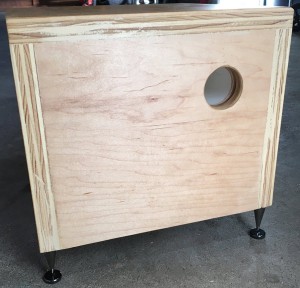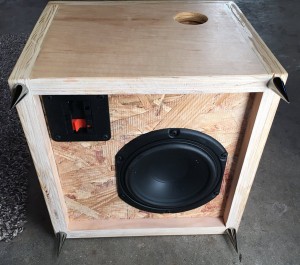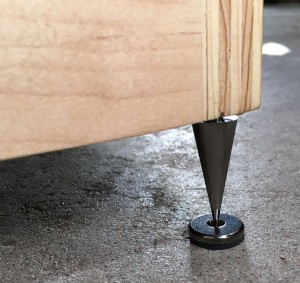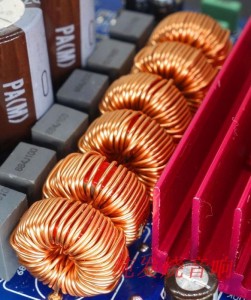I built a subwoofer! I made it to complement my Overnight Sensations.
Ode to Paul
If you don’t know what Overnight Sensations are, you should go read about them, purchase and build them right now. Then thank Paul Carmody profusely.
Pretty much the first and most helpful thing I found when looking into DIY audio was Paul Carmody’s website. A noob can read what he writes, even if some of the details are impossible to absorb for a newcomer. He has a lot of experience and knowledge, and he has no affinity for the high brow culture that seems to accompany all hobbies; Paul makes it easy to feel like you too could build some cool speakers.
He has many designs that are cheap to try out, and since he’s so well known and places like Parts Express sell kits of his designs, it is even easier to get started as someone who has never before soldered or understands crossovers in the least. It looks so effortless—of course it’s not—for him to be a resource to speaker builders worldwide; that’s most of the reason I tried to convince Ben to start this site with me.
One bit of improvement I would suggest if he ever reads this: add more detail in the description of his crossovers and their design, and how his final designs benefit from decisions he made along the way. There’s plenty of info out there about what these various kinds of crossovers are, but not what they should be. And what there is looks to be more braggadocio and urban legend than actual practical knowledge.
That said, there’s a lot of help on Paul’s site if you keep looking. Often, his older builds, while using outdated driver choices, have plenty of commentary that is very instructional.
Back to the Sub
Anyway, I built some Overnight Sensations this summer, and they are great. I bought the kit from PE (I built a Sprite too). Nothing extravagant, but they are already the nicest speakers I’ve ever had. I’m quite attached to them. In the ensuing splurge of buying all kinds of cheap buyout drivers from PE to play with, I ended up with a $15 5 1/4″ subwoofer driver—no longer available but I would likely try this one today.
So why not build a simple subwoofer enclosure to match my OS’s and bring in the last little bit of low end they can’t produce? I also had some nice plywood lying around from a remodel last year. A speaker plate with low pass filter (I think this one) for a couple bucks just about wraps it up—though I likely didn’t need it since I ended up with a 2.1 amp to run the sub.
So pretty much a whole subwoofer for around $20. Not bad.
Another good thing about the project: I was getting to the point where I had at least one of everything in the house. Another set of bookshelf speakers would just be in the way. I don’t want to be too wasteful pursuing this hobby, and a subwoofer felt like
- it could fit in with my other speakers,
- not be too hard to get right-ish, and
- give me a chance to work on both speaker-stuff and wood-working.
Feet from Parts Express
My only other major expenditure were the spikes. $12 from PE, but it took me a couple months to get myself to spend the $$$ on shipping from them. Seriously, someone should tell the bean counters at PE to amortize shipping across their products. I would buy so much more stuff from them if there wasn’t the psychological double whammy of not wanting to spend $100 a pop, and yet always feeling like I don’t have enough small stuff to justify the $6.95 flat rate.
I didn’t plan on the feet at first, but sorta backed myself into a corner with the wood. By the time I realized a couple feet made from the same plywood would look wrong, it was built. I was going to use rubber case feet—they are way cheaper—but they don’t come in long and skinny and I was worried not enough air would get in. Anyway, I think they look cool. Not a perfect match for the bronze colored HiVi drivers, but less of a clash than the tone-on-tone the brass spikes would give.
Trying to find the middle ground between what matters and what people just obsess over is really hard to piece out as you learn this hobby. If you check out the advice on downward firing subs, this driver isn’t quite recommendable for it. But I have two little boys, and the speaker grills have not yet worked so well for me. So downward it is. How much could I be risking? I also like the look. Just a box you can sit on with a little interesting tube.
Here is the sub in it’s natural environment.
The Mighty, Mighty TPA3116
Now this subwoofer I made isn’t a powered speaker. And subwoofer amps, usually plates, start expensive and go up from there compared to the little class D jobbers I’ve found to be fun and playful. At first I was planning to use one of the many chip amps I picked up as a subwoofer amp after splitting the audio signal to my stereo amp. Instead I gave into temptation and bought another amp: TPA3116, 2.1 channels, 2x50watt and 100 watt sub (@4Ω, somewhat weaker for these speakers). I had been wondering how much louder I could get these OS’s than with a TPA3118 or PAM8610 without killing them and had been googling TPA3116’s for a while.
I got the cheapest one I could find on eBay. You can see it in its place in the room shot above, just below the monitor and above the red microphone preamp. Here’s what they look like in product shots on eBay:
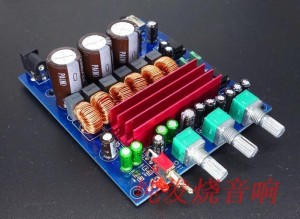
It’s not perfect:
- There is a hiss unless the stereo and combined volume are up all the way or down all the way,
- It was advertised as having an adjustable low pass for the sub. Not so. The three knobs from left to right are: stereo volume, sub volume, master volume.
- The red LED is on whenever the amp has power, not just when it’s turned on.
You may want to spend the extra $ to try and get a slightly better one, but it is LOUD (enough for some fun outside) and its faults don’t get in the way too often. Sure doesn’t make a 2.1 so it would be about $50 to get the same from them. On eBay, there are dozens of seemingly the same thing, and it can be really hard to tell if a few more bucks might actually get you something.
It’s rare to find these amps via Amazon, but here’s one like the one I bought for $20 with Prime. It’s great not to wait 3 weeks for these things to get here from China.
I’m sure these problems are not endemic to TPA3116; these chip amps are impossibly great: so much sound, so little heat, so little; definitely a big revelation from having grown up with giant AV receivers.
I love the way these chip amps look too. The row of inductors on this one are really great looking.
Final Thoughts
All in all, this has been a fun and rewarding project. Of course the sub’s design is not up to Paul’s standards, but I like the way it complements the sound of the OS’s. Since all I’m looking for is that oomph that the OS’s can’t deliver, and the amp allows me to dial in more or less of it at my whim, I don’t feel like I’m missing a lot by not having a better design. I do think Paul would approve of the get-your-hands-dirty first, obsess-over-sound-quality later approach to picking up DIY audio.

